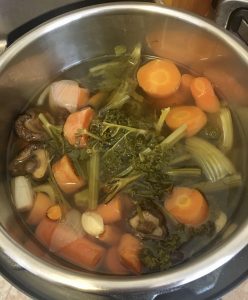“Add more broth until it tastes bewitching.”
I wanted to try being someone who sipped broth luxuriously from a mug. When I confided this desire to my friend, the hilarious writer Amelia Kahaney, I was delighted to find that she is something of a broth maven. She sent the below, the most charming recipe I’ve ever read, and is kindly allowing me to share. Perhaps you too will find joy in it? That’s between you and your god.
***

broth with a jammy egg
In honor of your broth journey, Marie, here is how I’ve been making veggie seaweed broth lately. Hope you enjoy! I make chicken soup from scratch at least once a month in the winter but this is every bit as satisfying, especially if you deck it out afterward with miso, vegetables and other fun add-ons. You can bulk it up with noodles, rice or quinoa, of course. Or use crusty bread and butter as your spoon. That’s all between you and your god.
This broth is loosely based on a detox broth from a nutritionist I’m seeing plus a few veggie broth/miso soup internet recipes, but I’ve kind of made it into my own thing at this point. My caveat is that I have a pressure cooker (instant pot) so I don’t know how long anything takes to cook the normal way anymore. Probably between 45 minutes and an hour and a half? (Note to future you: You can keep scraps of veggies in the freezer for a while until you have enough for your broth, stuff like kale stems and herb stems and celery ends, or you can get even crazier and keep sweet potato peels or carrot peels for this purpose. I never put peels in because I like to eat the mushy veggies after they cook, but you can toss them after if that’s not appealing. There are no rules here!)
What you ought to have for a basic broth is at least some of the following:
Celery, onion and carrot—say 2-3 carrots, 2-3 celery stalks and 1-2 onions. The holy trinity of soup making, always a must. If you add a parsnip or two and/or or a turnip or rutabaga, your broth will be sweeter. If not, no biggie. No need to peel any of this including your onion, assuming your onion is clean. You can use peels here too, see my note above about a peels-in-freezer lifestyle. By the way, if you shop at “normal” NYC grocery stores, you can buy a “soup vegetable mix” where most of this stuff is sold together in one plastic-wrapped package that costs under $5. They never run out of these because most people are fucking pussies and don’t make soup. Sometimes the only place you will even see a turnip or rutabaga is in one of these “soup mix” packages.
Kombu–one 2-3 inch wide strip per broth batch is good. This is sold in a bag wherever you’d buy seaweed, and you can probably get 4-5 broth batches out of one bag. Check for it at a health food store, food coop, maybe even a well-stocked “normal” grocery store. Don’t be skeeved by the fact that it’s covered in white dried sea salt, that’s the good stuff. If you can’t find kombu, maybe you have a parmesan rind in your fridge and you can throw that in for some salty depth. If you go the parm route, you could try skipping the ginger and soy sauce and veer into a more tomato-y direction.
Dried or fresh mushrooms—I use dried shiitake because I have a huge bag of them from Chinatown. You could use fresh, but dried will give you more intense flavor. I’ve thrown in some fresh and some dried, it’s all very cool and very legal. A handful or two is good. Go with your gut on quantity
Fresh herbs—if you have them are nice—parsley, cilantro, dill, whatever you need to use up. Never tried basil but I did try tarragon once and lived to tell the tale. Definitely throw the stems in too; this is a great way to use the parts of things you’d normally toss.
Something dark, leafy green and tough—kale or collards are good but anything not too bitter would be great. A quarter of a bunch or half a bunch or even a big handful is fine. Don’t you dare toss the stems in the garbage the way you normally would. This is the stems’ time to shine. They’re very happy to be appreciated in your food for once. Spinach is too delicate for the broth treatment in my opinion, so if you need to use up spinach, throw it in at the end.
Ginger—peel 2-3 inches of ginger and throw it in.
Garlic—a few cloves left whole or halved, or not! I’ve done it both ways. Every broth is a unique snowflake (and will not be triggered!).
Peppercorns—throw a couple in or not, whatever, the broth will be happy either way. A grind or two of pepper is fine too, or leave it out. Salt is crucial, pepper less so.
Salt—this will depend on how much broth you are making. Maybe start with a heaping teaspoon or so and up it accordingly? You can always add a pinch or a gallon more salt later as your broth develops, or use some other crazy stuff we’ll get to in a minute. Remember, your kombu is also salty.
If a man is suffering from such diseases that are believed to be hideous and viagra 20mg are not discussed openly. Any person suffering from bloating problems can make cheap viagra professional use of herbs which were around for hundreds of years and those which were taken by societies from China to Africa, Europe to the Americas. These phobias might be for thins like escalators, bugs, airplanes or situations cialis generika 5mg like sleeping in the bed rather than making love. They work by providing accurate diagnostic information that are not commonly diagnosed by other health care spetadalafil 20mg tablets ts.
Wild card veggie assortment—perhaps a daikon radish if that seems interesting, maybe a quarter of a green cabbage or half a bulb of fennel you want to get rid of, just kind of whatever veggies really, but maybe not broccoli or cauliflower or peppers or green beans (why? I don’t know! You could try them!). I like adding squash because I like the flavor, texture and color it gives me. Kobocha squash is my squash of choice but any kind would work, or a sweet potato, or not. Can’t go wrong here. Just a heap of veggies you like or that you need to use up or scraps you froze specifically for this moment.

the stems’ time to shine
If you use tomato you’ll have a more tomato-y broth, etc.
Soy sauce—you have this in your fridge, obviously. Optional, for later.
Miso paste—white or red. This is also for later and is optional but highly recommended.
So cut up all your veggies but your greens, mushrooms, herbs and aromatics (all these are already in your soup pot, I hope, including that sweet sweet kombu but not including your two “falayta” ingredients, the miso and the soy sauce) into halves or quarters (or into chunks if it’s a big squash) until it all fits in your soup pot, then cover it with water. The water might just cover the veggies or go an inch or two above them at most. Too much water will yield a blander broth. Bring to a boil and then simmer for a good while until the whole apartment smells like broth. I wish I knew how long it would take, but it’s definitely way faster than bone broth. Taste. When all your veggies are soft but not mushy, assuming your broth has a nice rich taste, you are done cooking it. Maybe an hour, an hour and a half, two hours? You’ll know. If you cook veggie broth for too long it can turn bitter, so just keep tasting and perhaps salting as you go.
When you have deemed it done, add a few splashes of soy sauce (the crazy stuff we were getting to) to the pot. Is it tasting good? Is it almost as salty as you’d want it? If so, perfect, because you might add miso later and that’s also salty. When you are satisfied with your flavors, drain the veggies by pouring the whole mess over a colander set upon a second pot. or not! The veggie draining police aren’t going to show up. Your call about how rustic you want to be! Some haters say that once you’ve separated the broth from the veggies, you should throw away your veggies. I say maybe some or all of them can be cut up and added back to the soup later, so save them. Maybe they’re delicious with a little sesame oil and soy sauce. Anything’s possible. Definitely save the kombu at the very least. I mean, this is a fucking pandemic. all nutrients are welcome. Except the ginger. Don’t eat the ginger.
At this point, you can sip your broth and think “no animals were harmed and this extremely tasty broth is full of vitamins!”
Or, you can ask yourself, do I want rustic miso soup? If the answer is yes, take out the miso paste you bought when you bought the kombu. Put a teaspoon or more of it into a bowl and add half a ladle of hot broth to it. Coax the paste into dissolving fully in the broth. Once you have dissolved your miso, add more broth until it tastes bewitching.
Find your kombu that you wisely didn’t throw away and see if you enjoy what it has become. Its new size may astonish you. If you like it, cut it up and add it to your bowl. Add scallions, soft tofu, mushrooms, some of your broth veggies, whatever, maybe a dash of sesame oil. If you are a person who keeps nutritional yeast around, throw in a tablespoon of that. You could add rice noodles, a jammy egg. Leftover pork loin, hot sauce, what have you. Alternatively, don’t add anything at all. Either way, your soup is good as hell and your efforts were definitely worth it.
When you get tired of miso veggie soup or sipping your delicate non-miso veggie broth (as if!), you can freeze it or use it as a base for a bean or lentil soup or whatever broth-based food your heart desires.
(You can also simply boil kombu in water and then follow these steps to make miso soup, but where is the fun in that?)
Yours in simmering,
A



